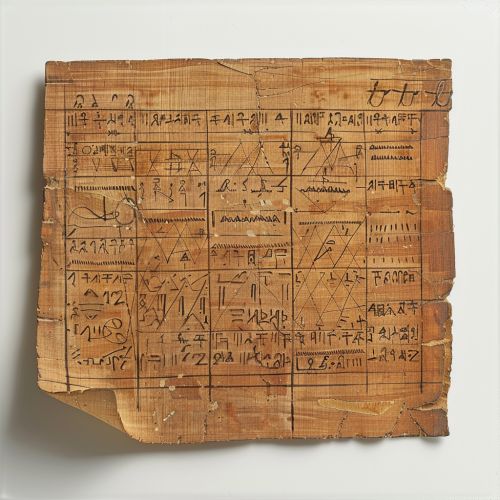Rhind Mathematical Papyrus
Introduction
The Rhind Mathematical Papyrus (RMP) is one of the most significant artifacts from the Ancient Egyptian period. Named after Alexander Henry Rhind, a Scottish antiquarian who purchased the papyrus in 1858, it is a comprehensive document that provides insight into the mathematical knowledge and practices of the Ancient Egyptians.


History
The Rhind Mathematical Papyrus dates back to around 1550 BC during the Second Intermediate Period. It is a copy of an even older document that is believed to have been written during the reign of King Amenemhat III in the 12th Dynasty, around 1850 BC. The papyrus was found in the ancient city of Thebes and is currently housed in the British Museum.
Content
The Rhind Papyrus is primarily a mathematical text, containing a series of arithmetic and geometry problems. It is written in the Hieratic script, a cursive form of the more well-known Hieroglyphic script. The text is arranged in a vertical column on the front and back of the papyrus, with the problems and their solutions presented in a horizontal format.
The papyrus contains a total of 84 problems, which include calculations related to practical issues such as the distribution of bread and beer rations, the calculation of areas and volumes, and the solution of linear equations. These problems provide a glimpse into the daily life and practical concerns of the Ancient Egyptians, as well as their mathematical knowledge and problem-solving techniques.
Mathematical Concepts
The Rhind Papyrus demonstrates the Ancient Egyptians' understanding of several mathematical concepts, including fractions, algebra, geometry, and number theory. The Egyptians had a unique system for representing fractions, using only unit fractions (fractions with a numerator of 1) and the fraction 2/3. The papyrus also includes problems that involve solving simple linear equations, demonstrating an early form of algebra.
In terms of geometry, the papyrus contains problems related to the calculation of areas of rectangles, triangles, and circles, as well as the volume of a truncated pyramid. The Egyptians' method for calculating the area of a circle, as demonstrated in the papyrus, is particularly noteworthy. They approximated the area of a circle by squaring 8/9ths of the diameter, a method that gives a value for pi of approximately 3.16.
Significance
The Rhind Mathematical Papyrus is a key source of information about Ancient Egyptian mathematics. It provides evidence of the Egyptians' mathematical knowledge and problem-solving techniques, and it offers insights into their practical concerns and daily life. The papyrus also demonstrates the Egyptians' ability to abstract and generalize from specific problems, a key aspect of mathematical thinking.
